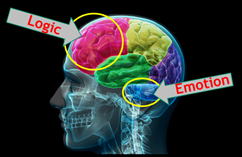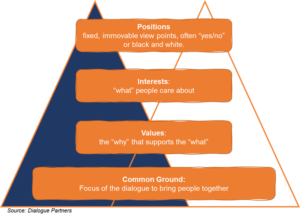We make hundreds of decisions every day. And about 90% of them are so routine that our unconscious mind makes them: you intuitively drive a car, brush your teeth, and mindlessly eat a tub of popcorn while binging episodes of your new favourite show.
On the flip side, conscious decisions take effort. Those are the ones that shock your brain into working. Think about the conscious effort you put into wondering about your company’s post-COVID return to work policies; whether your customers are ready to come back to you; what changes you need to make to survive in today’s economic climate. Conscious decisions are hard decisions.
Decisions are hard enough when it’s just YOU involved. But what happens when you need to lead your team through tough decisions? The more people involved, the more complex it gets. This post addresses how you can lead your team through hard decisions, and how to get into the emotions and values that make hard decisions even harder.
Why are Some Decisions Harder Than Others?
You may be thinking, “Well, that’s a dumb question, the answer’s simple.” But we’re human, and humans complicate things. Humans have different personalities, think differently, have differing levels of emotional investment in an issue, and are driven by different values.
According to Decision Innovation, there are three types of decisions:
| 1) Consumer | Purchasing decisions, either in business or personal. (E.g. Which laptop to procure for the team; which house to buy for the family; how to optimize spending on Amazon Prime day, etc.). |
| 2) Business | Those that determine the course to set and achieve business outcomes. (E.g. Vision, mandate, strategy, products/service design, organizational structure, etc.). |
| 3) Personal | Tied to life choices. (E.g. Career, family, lifestyle, etc.). |
I’m going to go a little deeper than these types, because when leading team decision-making, you’ve got to acknowledge that hard decisions are multi-layered. There may be consumer, business and personal factors in a decision, and a lot of human influences. I’m proposing another way to think about hard decisions, which factors in the human element.
1. “Easy-Hard” Decisions – Data-Driven Tradeoffs
These decisions are those that have serious implications yet can be worked through using data and an analytical process. Yes, there is always a level of interpretation and guessing, but generally choices can be backed by the data. Decisions like these are when setting strategy; when leading a restructuring; or reconfiguring a service.
Decisions like this require tradeoffs. Team members may have differing opinions on the merits of one course over another but using data can at least provide logic and justification for the choice. Moreover, especially in a business type decision, easy-hard decisions are often aligned to specific goals and measures. A team can use overall business direction to ground the parameters for the decision. These easy-hard decisions are often made using a structured decision-making processes (and there are a lot of them out there: E.g. 7 Step process; 5-Step Process etc.).
2. “Medium-Hard” Decisions – Emotions Run High
 This is the level of decision making that generates cognitive biases and, more importantly, emotions. When there’s a decision facing a team that results in an emotional response, the decision-making process can often go astray.
This is the level of decision making that generates cognitive biases and, more importantly, emotions. When there’s a decision facing a team that results in an emotional response, the decision-making process can often go astray.
Often emotions during decision-making result from our cognitive biases. There is a lot written about the types of cognitive bias and how to overcome them during decision making – which can also remove the emotional aspect. These aren’t new concepts, but without a concentrated effort to recognize bias, we’ll often fall into it because it’s intuitive. Our brains naturally want to seek patterns and the “oh I’ve done this before so we should choose this course” regardless if it’s the right call. That’s what makes these decisions harder. We’re grounded in our biases and often trigger emotional reactions.
3. “Hard-Hard” Decisions – Our Values are Challenged
Decisions which challenge our values are the hardest of them all. I’m sure you can think back to a meeting or discussion when you felt uncomfortable – and perhaps weren’t sure why. When facing this kind of decision, our vulnerabilities are exposed. This discomfort is often classified as cognitive dissonance, when there’s a conflict between values, beliefs and actions. When faced with a decision when our values are challenged, we seek to find a solution that will reconcile our values with the decision’s outcomes.
Because values are so individual and personal, leading a team when there are conflicting values is the most difficult.
Cut to Values to Make a Hard Decision
 Team decision-making is all about constructive dialogue. And the dialogue often can’t happen until we understand our team’s emotions and values. Once those are in place, we have common ground from which to come to a decision.
Team decision-making is all about constructive dialogue. And the dialogue often can’t happen until we understand our team’s emotions and values. Once those are in place, we have common ground from which to come to a decision.
This “iceberg model”, created by Dialogue Partners, shows that people’s positions, interests and values need to be addressed before reaching common ground:
I’m going to describe a few steps that can help you lead your team to find common ground, regardless of the type of decision. Before I get into it, I need to mention that there’s an underlying assumption that your team members trust one another and can constructively work through conflict. Patrick Lencioni’s 5 Dysfunctions of a Team notes that teams that have not built trust or learned to manage conflict often struggle to be high-performing or to have the tough conversations that lead to better decisions. The steps I’m outlining below work when your team is able to be open and trust each other and discuss topics constructively.
1. Discovery – Create the Space
As a leader, create the space where people can feel open to discuss and understand the issue they’re being asked to deliberate. Bring the team together to define the decision. Unpack as much of the complexity and be clear about the decision. For example: How can we improve our customer’s onboarding experience? How do we reduce 15% of our operational cost? Get agreement from all team members that that is the right issue to consider.
Once confirmed, align everyone on the principles they will follow to make the decision. For example, is it consensus-based? Who needs to be involved in making the decision? Who ultimately makes the call?
Discovery discussions can reveal team member’s positions on the issue. You may hear someone say: “Our customers love us…why bother looking at their onboarding journey?” Or, “The HR team is totally overbuilt. Let’s just outsource it.” After discovery discussions, give the team at least one day so the team can absorb the issue and:
- Gather relevant data;
- Identify their biases and what emotions may be triggered; and
- Determine how their approach to the decision may challenge their values.
2. Build Awareness – Self and Team
During the time between discovery and decision-making, encourage team members (and yourself) to reflect why they hold their position. If you’ve never taken the time to step back and understand why you hold your biases or values, Brené Brown’s Dare to Lead offers tips on how to identify your own values, and walk through a team values exercise too. I won’t get into detail here (it’s a whole new topic!). Brown encourages identifying only two core values. Here’s a list of values as a start.
Be aware of not only speaking with bias, but hearing with bias. Ever heard someone’s position and automatically dismissed it? Being aware of your bias helps you stay open to hearing others interests – and more importantly, ensuring you stay open to others. Hearing bias can pre-judge a decision and restrict open dialogue.
Knowing yourself helps you understand how to better to lead your team. And knowing your team members’ interests and values can help you be more empathetic during a conversation.
3. Prepare to Lead
You’ve identified your position, bias and values as you built self-awareness. Now prepare yourself to lead a tough conversation. Consider:
- Where will you hold the discussion? Office boardroom? Off-site? In-person or virtual? What location will be most conducive to support your team members?
- How will you overcome blocks? What if a team member refuses to budge from position to get into interests and value? If you anticipate this happening, is there anything you can do to work with that individual before the decision-making meeting?
- Are you prepared to listen without judgement? What strategies can you put into place to keep your own biases in check?
- What tools and techniques (check out mindtools.com) will you use to lead the discussion? How free flowing or structured do you want to be?
- Are you the right person to lead the discussion? Would you benefit from an objective third-party so that you can participate? What are the pros/cons of leading vs. participating?
Preparing yourself to lead a hard conversation is critical to “show up” well for your team.
4. Lead the Decision-Making Conversation
You’ve identified the issue. You know where you stand and why. You’re ready to lead. Let’s have the conversation:
- Acknowledge that this is hard. Appreciate the team’s participation.
- Ground the team in the decision they agreed to focus on. Use a “parking lot” to capture items that are not directly related to the issue. Bring people back to the topic when people go on a tangent. This often happens as a defense mechanism to avoid becoming emotional when uncomfortable.
- As you work through the decision, acknowledge emotion and discomfort. Ask probing questions to go beyond positions and into interests and values, like:
- What about this topic concerns you? What more can you tell us about that?
- What are you hearing from others around this table that aren’t sitting well with you? Why is that?
- What are consequences of not moving on this decision?
- Watch for patterns and people trying to take the “easy”, intuitive route.
- Build in breaks and physical movement.
- Veer off your plan if you need to. You can prepare all you want, but sometimes the conversation goes down a path you didn’t anticipate. That’s okay. Keep focused on what you needed to achieve and adjust.
 5. Trust your Decision
5. Trust your Decision
Once your team has decided, lead confidently trusting the decision you’ve made is the “right one, for right now.” This can become as you move into implementation. A big decision will multiply into hundreds of smaller, interrelated decisions. To stay confident in your path:
- Go back to discovery – stay focused on the intent you needed to resolve this issue.
- Remember the data, emotions and values that were at play when you made the decision – are you still aligned and behind the choice? If so, then stay confident. If not, check to see which factor may be affecting your confidence in the decision.
- Assign accountability and support each other when implementing. Encourage each other to complete resulting actions and stay empathetic when the inevitable doubt and frustrations creep in. Stay focused on the outcome and believe in the path you’ve all chosen.
- Adjust when needed! Expect that unexpected things will happen. Stay true to the values that contributed to making the decision – that will keep your confidence high and dissonance at bay.
It’s not Easy – Seek Support!
Hard decisions challenge us as individuals and when we lead our team through them. We’re in the spotlight and often blamed if a decision results in unpopular results. Understanding what issue you’re solving and what you feel about it can bring awareness to the way you lead. This requires you to be open to looking into yourself and your own motivations so you can empathize and lead effectively regardless of the type of decision – in business or in life.
If you’re struggling with how to make lead through tough decisions, reach out to trusted advisors, mentors and friends. Spinning in your own mind is never helpful! It’s hard, but be confident and dive in!



